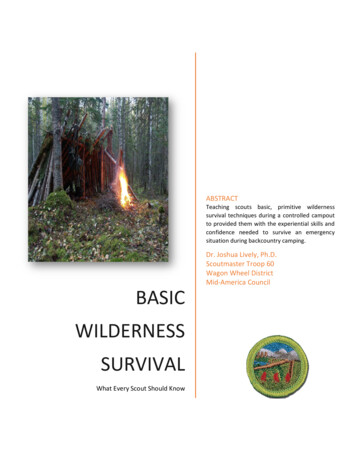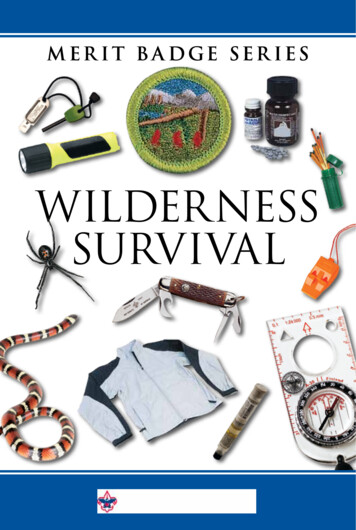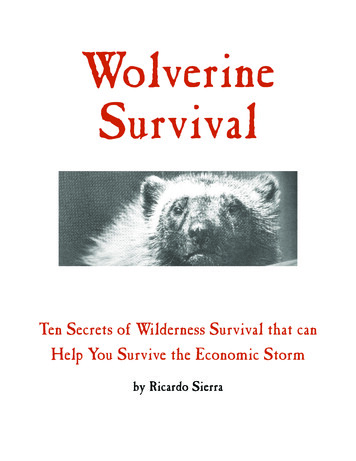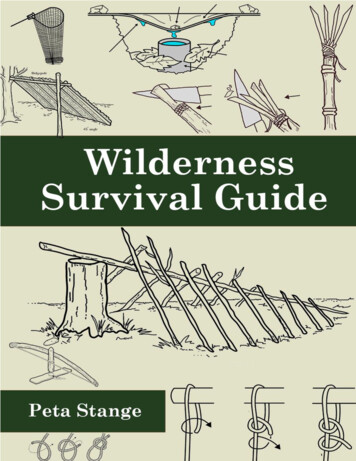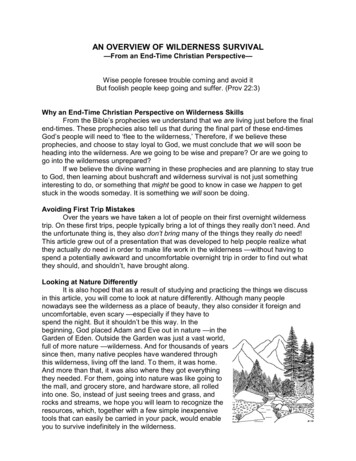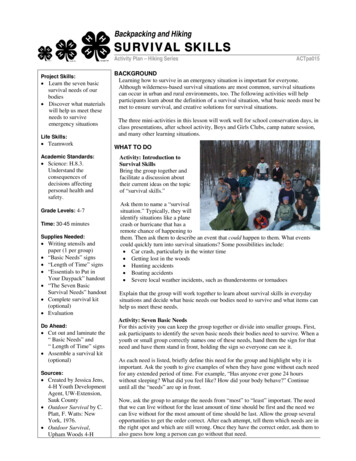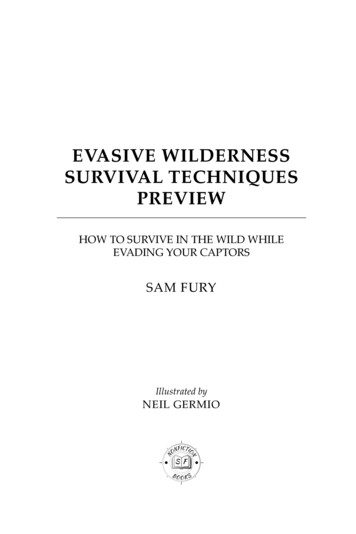
Transcription
EVASIVE WILDERNESSSURVIVAL TECHNIQUESPREVIEWHOW TO SURVIVE IN THE WILD WHILEEVADING YOUR CAPTORSSAM FURYIllustrated byNEIL GERMIO
Copyright Sam Fury 2020www.SurvivalFitnessPlan.comAll Rights ReservedNo part of this document may be reproduced without written consent from the author.
WARNINGS AND DISCLAIMERSThe information in this publication is made public for referenceonly.Neither the author, publisher, nor anyone else involved in theproduction of this publication is responsible for how the reader usesthe information or the result of his/her actions.Consult a physician before undertaking any new form of physicalactivity.
CONTENTSIntroductionResources and Improvised ToolsKnivesBlade-SharpeningClubsCordStealth MovementObservationCover & ConcealmentCamouflageModes of MovementEvade TrackersMap and Compass NavigationSurvival NavigationMove SafelyOvercome ObstaclesPredict Bad WeatherSheltersClothingShelter Security
viExisting SheltersLean-To SheltersTrench ShelterImprovised BedsWaterConserving WaterFinding WaterWater FiltrationWater PurificationWater DistillationFoodCookingEdible PlantsInsectsWater ForagingFishBirdsReptiles and AmphibiansDead GameFireGather FuelTeepee FireContents
ContentsDakota Fire HoleIgniting the FireFriction FiresFire MaintenanceRescue SignalsTypes of Rescue SignalsBonus MaterialsAuthor RecommendationsSurvival Fitness Plan Training ManualsAbout the Authorvii
INTRODUCTIONEvasive wilderness survival is the ability to keep yourself alive in awilderness setting while avoiding capture (or recapture) by yourenemy. An example scenario of this may be escaping a hostage situ‐ation where you were held captive in the wilderness.This is the hardest type of wilderness survival there is, and the besttype of survival to learn.Evasive wilderness survival training focuses on worst-case scenarios,but is easily adapted to general wilderness survival. In fact, if youcan survive in the wilderness under evasive circumstances, then nonevasive survival situations become much easier.There are three key elements for succeeding in evasive wildernesssurvival:Minimalism. When you escape your "prison," you willprobably not be able to take much with you.Evasion. Staying hidden from your enemy so you canavoid recapture.Staying on the go. Surviving while continuously movingaway from your enemy and towards friendly territory. Yourobjective is to get to safety ASAP.This no-fluff manual contains all the information you need to evadeand survive in any terrain or climate, whether it be jungle, desert,arctic, etc. Even if these are the only wilderness survival lessons youlearn, you will be very well equipped.TrainingFew people will carry a survival guide with them. It’s better to learnthe information (through practical activity where possible) so thatyou have the knowledge and hard skills.
xIntroductionYou can use any single chapter from this book as a practical activityand/or a theory lesson, either individually, in succession aspresented, or compiled into a multi-day survival course.When training in this subject, please observe eco-friendly practices.Do not cut down live trees or kill animals. These things are okay inreal survival situations, but not in training.Local KnowledgeEvery place in the world is different. You can adapt many survivalskills (like the ones taught in this book) to a variety of situations, buthaving specific knowledge of the area you’re in will make survivaleasier. Research the specific areas you’re commonly in and/or planto go to. Find out about the animals, useful plants, weather, etc.Survival NeedsAs an evasive survivor, you have needs that are the same as those ofany wilderness survivor—namely food, water, shelter/warmth(clothing), fire, rescue, self-defense, first aid, and navigation.However, you must also consider stealth while obtaining thesethings.The specific things you need to acquire first depend on your situa‐tion, but the rule of three will be a consideration.You can survive for three:Seconds without blood.Minutes without air.Hours without shelter.Days without water.Weeks without food.Months without human company.
IntroductionxiThe Will to LiveA big part of survival is maintaining your will to live and a strongbelief that you will survive. Remember your reasons for living (e.g.,loved ones) and have faith in yourself, your abilities, and your god ifyou have one. No matter what happens, do not give up your will tolive, and always be prepared to seize opportunities.
RESOURCES ANDIMPROVISED TOOLSObtaining a few items before you escape will make wildernesssurvival easier, but too much stuff becomes a burden. You also needto consider evading your enemy. Anything that will make noise orreflect light while you move will give you away.Gather things that will help you meet your survival needs. Here’s alist of those needs, with related items in parentheses:Shelter (winter clothing, poncho, cordage).Water (purification tablets, hiking filter).Food (fishing tackle, candy bars, foraging guide).Fire (matches, lighter, ferro rod).Medicine (first aid kit).Rescue (mirror, whistle, flashlight).Navigation (map, compass).Self-defense (knife, gun, club).Your ability to gather survival resources before escaping may beminimal, but there will be additional opportunities once you’re onthe run. Always be on the lookout for useful items. A broken-down
vehicle, for example, can provide cordage (wiring), fire (battery),digging tools (hubcaps), signal mirrors, and more.Whatever resources you do have, ration them from the start. Even ifyou expect a quick rescue, things can go wrong. When you firstescape, it’s better to consume rations than to spend time scavenging.Once you have enough distance, live off the land as much as youcan and conserve any excess stores for as long as possible.
KNIVESA good knife is arguably the most useful survival tool there is.If you have a choice, choose a carbon-steel blade with a V grind(Scandi grind). They are good all-around survival knives, and areeasier to sharpen with improvised abrasives than knives made fromother materials.In an evasive survival situation, your chances of obtaining a realknife are slim. Here are some ways you can improvise one. If yourenemy is close, consider the noise you will make constructing thesebefore you do so.Glass, Plastic, and MetalYou can turn hard plastic or soft metal into a blade by heating it upand hammering it into shape between two rocks before it cools.Sharpen the edge. Glass will already be sharp, but you can sharpenit more.BoneThe larger the bone, the larger the knife you can make. Clean it wellfirst.Find a large, flat, hard rock for a table. You also need a hard,medium-sized stone with a round surface. This is your hammerstone.
4S A M F U RYPut the bone on the table and use your hammer stone to shatter it.Choose the best fragment to use as a knife. Ideally it will be onepiece, with a sharp edge section and a handle section. Sharpen theedge more if you need to.StoneStone blades are good for puncturing and chopping, but most won’thold a fine edge for long. Some exceptions are chert or flint.First, look for a stone that already has a sharp edge. If you can’t findone, making one isn’t too hard, provided you can find the rightstones.To make a stone blade, you need two stones. The first is your bladestone. The bigger your blade stone, the easier the knife is to make. Italso means you will get a bigger blade.Look for a stone with a glassy surface. Check near rivers and creeks.If you find two of them, they should make a ringing, glass-likesound when hit together. Chert, flint, obsidian, and quartz are goodexamples.The second stone you need is a hammer stone. Look for a hard,medium-sized round stone.Place the blade stone on a larger rock, or on your thigh, and hold itfirmly in place. Smack the hammer stone down on the edge of theblade stone, but don’t do it too hard. Follow through with a strong,glancing blow. When you do this correctly, blades will chip off thebottom of the blade stone. Sharpen their edges more if you need to.Wooden Knife HandleYou can use improvised blades as they are, or make handles fromwood. To do the latter, split a piece of hard wood, insert your blade,and tie it in.
Evasive Wilderness Survival Techniques Preview5Related Chapter: Resources and Improvised Tools BladeSharpening
STEALTH MOVEMENTIn this section you’ll discover how to leave minimal signs of presencewhile evading your enemy. You’ll also learn navigation, safe ways tomove in various terrains, and more.
OBSERVATIONConstant observation using all your senses is required when you’removing. Even when you stop, you must keep observing. Observeyour enemy and/or any obstacles in your way, so you can choosehow and when to move.Searching GroundUse this method to look for signs of your enemy, or anything elseyou want to look for, from a stationary position. It will help if youhave something specific to look for (certain equipment, humans,dogs, vehicles, etc.).Divide the ground into three ranges: immediate, medium, and long.Scan each section from right to left. Start with the immediate range,and work your way back systematically.Right to left is better than left to right because we read from left toright and are more likely to overlook things if we follow that habit.Horizontal scanning is better than vertical, as that way you don’thave to be continuously adjusting for distance and scale.When you come across areas that are more likely to hide something,take a bit more time to search and look for parts of objects as well aswhole ones. Things may be hidden behind something, but with bitsof them still visible.Look through visual screens, e.g., vegetation. If you want to lookfurther, make a small head movement.Tips for Seeing in the DarkIt takes 30 minutes for your eyes to fully adjust to the dark (nightvision) and you need at least a little ambient light from a source likethe moon.
10S A M F U RYOnce your eyes have adjusted to the dark, you need to protect them.A flash of light can ruin your night vision in a second. When there isa bright area you want to observe, cover one eye to preserve it whileyou use the other one to look.Even with your night vision, objects in the dark are harder to makeout. Looking next to them will make them clearer. Changing yourfocal point every few seconds (up, down, to the sides) will also help.Things may seem to move. Make sure they’re staying still with thesticky finger method. Stretch a finger out in front of you and "stick"an object to it.When you need extra light to see (if you’re reading a map, for exam‐ple), use red or blue light. It does minimal damage to your nightvision and is harder for your enemy to spot. Don’t rely solely onyour vision. Sound, smell, and touch can tell you many things.Hearing is a human’s next best sense, and you can often hear thingsthat are out of sight. Stay still, open your mouth a little, and turnyour ear in the direction you want to hear.The wind can carry smells quite far, and some smells, like foodcooking or smoke, are very distinctive to humans. Turn your nose uptoward the wind and smell like a dog does, taking many small sniffs.Concentrate on the inside of your nose and try to determine whatthe smell is.When you can’t see anything at all, it’s safer to stay still until there’slight, but certain circumstances may require you to move. In thiscase, you need to feel your way around. Move slowly, testing everymovement.Lift your feet high to give yourself the best chance of clearing anyobstacles, but ensure you do not lose balance. Stretch your hands infront of you to feel for obstacles. Use the back of your hand to feelstuff, in case it’s sharp or hot. This will protect the inside of yourhand and the arteries in your arm.
SHELTERSBuilding a shelter is not ideal in an evasive survival situation. It’stime-consuming and can leave large signs of presence. But if you’reon the run for long enough, you’ll need to rest eventually, either toprevent injury or to protect yourself from extreme weather.When the weather is fine, crawling into the thickest vegetation youcan find will keep you hidden. If the vegetation is thick enough, itwill even keep light rain off you. Another option is to dig a depres‐sion, crawl in, and cover yourself with foliage.When the weather is extreme, you need to construct a shelter. Thekey to a good evasive shelter is to keep it simple. You need it to befast to make and dismantle, and to show the least sign of presencewhile you occupy it and after you leave.Specific ways to make shelters are detailed in the following chapters,but there are some extra points you need to know for desert andsnow shelters first.
Desert SheltersIn the desert, it’s vital to keep cool during the day. If you have somematerial to build your shelter, use it in a way that maximizes airflow:Place the material about 50cm (20in) from your head.Create a 40cm (15in) airspace between the sheets. Avoidcutting the material. Fold it in half instead.Arrange it so the lightest side faces out to reflect heat, butonly do so if it won’t attract your enemy.Snow SheltersIn the snow, you need to stay warm when you’re not moving, andyou may need to make snow blocks to construct your shelter.Choose snow that you can cut, but that’s also strong enough tosupport your weight. Make the blocks 50cm x 50cm (20in) and15cm (6in) thick. When constructing your snow shelter, ensure theentrance faces away from the wind. Insulate the floors with vegeta‐tion (or whatever is available) and pile snow around the sides.Brush off all snow and frost before entering, and keep a shovel closeby in case you need to dig yourself out.It’s best to keep your shelter at least 5m (15ft) from the edge of abody of water, even if that water is frozen. The freezing andthawing of ice/water will change its level.
CLOTHINGAdequate clothing can prevent the need to make a shelter, and canhelp to protect you when you’re on the move. Here are some generaltips to get the most out of clothing, as well as how to improvise it.No matter what environment you’re in, loose-fitting clothing is best.Cover as much of your skin as possible and take care of what youhave. Keeping your clothes clean and dry will prolong their life.Make any repairs as soon as possible to prevent the damage gettingworse, and always keep your clothes off the ground and shake themwell before putting them on.Dressing for WarmthTo maximize insulation, use the layer system. The more layers youhave, the warmer you will be. If that is not enough, stuff dry insu‐lating materials (leaves, grass, feathers, moss, paper, car seat foam,etc.) between your layers of clothing.Outer garments should be windproof, but not waterproof. Animalskins are ideal and wool is better than cotton. If clothes made fromimproved materials are available, use them.WaterproofingPlastic is a good waterproofing material, but it doesn’t breathe. Useit to protect you from the rain, but be careful of it hinderingventilation.When plastic isn’t available, use large sections of birch bark. Discardthe outer bark and insert the inner layer under your outer clothing.
14S A M F U RYGaitersGaiters protect your lower legs from insects, low-lying foliage, sand,snow, etc. Most materials will work. Wrap them around your legsand tie them in place.HeadwearWearing a hat protects you from the sun, and will prevent body heatescaping through your head.You can improvise headwear with some cord, a handkerchief, and a120cm x 120cm (50in x 50in) piece of cloth. This design protectsyou from the sun while ensuring ventilation, which is important inthe desert and other hot areas.Make the handkerchief into a wad on top of your head.Fold the cloth diagonally into a triangle and place it overthe handkerchief, with the long edge forward.Secure it around your head with a piece of cord.If you only have one piece of material, you can forfeit the ventila‐tion gap and use it as a keffiyeh. Fold the material diagonally into atriangle and place it over your head, with the long edge forward.Fold the left side of the cloth over to the right side of your face, justbelow your eyes.Wrap it around your head and tuck it in. Do the same thing with theright side going left.
Evasive Wilderness Survival Techniques Preview15You can have your mouth and/or nose covered or pull that partdown.Mosquito ProtectionMosquitoes are annoying and a health risk. The best protectionfrom them is to keep covered, especially at dusk, dawn, and duringthe night. When your clothing is inadequate, covering exposed skinwith oil, fat, or mud may help.Campfire smoke deters mosquitoes and other bugs, but is not a goodidea in a covert situation.PonchoImprovise a poncho with any piece of material that’s large enough,such as a blanket or bedsheet. Use plastic if you want it to be water‐proof. Find the center of the material and cut a hole for your headto go through.ShoesProtecting your feet is important. Make improvised moccasins withtwo pieces of fabric 1m squared (more layers are better) and cord(optional).If you have multiple layers, place them on top of eachother.
16S A M F U RYFold the layers together into a triangle.Place your foot in the center, with your toes facing thecorner.Fold the front over your toes, then fold the side corners overyour instep.Secure each shoe with cord or by tucking the layers intoeach other.You can make thicker soles from other material, such as rubber tiresor bark.When you have soles and cord but no fabric, make holes around theedges of the soles and tie them on like flip-flops.SkirtSkirts are good for warm climates. Wrap any piece of material largeenough around yourself like a sarong. Tie it in place if you havecord. Alternatively, tear leaves and fibers into long strips and tiethem around a cord “belt” so they hang down like a hula skirt.Sun/Snow GlassesGlasses help to protect your eyes from dust, glare, and other things.To make improvised shades:Find a strip of fabric wide enough to cover your eyes andlong enough to tie around your head.Place the middle of the fabric between your eyes and markwhere your eyes sit.Cut small, horizontal slits where you marked it.Tie the fabric around your head so you can see through theslits.When you don’t have any spare fabric, use bark. Another way toreduce glare is to put soot under your eyes.
WATERWater is essential for life and you will not last long without it, espe‐cially while running from your enemy.Although it’s not always easy, there are ways to acquire water in anyclimate. Unfortunately, many sources of water are not suitable fordrinking, and using them can make you ill. Therefore, you mustlearn how to find water and how to treat it.There are two basic ways to treat water: filtration and purification.A good water filter can eliminate many harmful types of bacteria,but it will not eliminate viruses. Purification will kill the viruses.Ideally (besides having fresh drinking water), you’ll filter water firstand then purify it. When doing both is not possible, one or the otheris better than nothing. Always treat the clearest water you haveavailable.
CONSERVING WATERWhen water is abundant, drink a minimum of one liter a day. Whenyou’re active, you’ll need more. This is true no matter what theclimate. Your body still loses liquid when it’s cold, and dehydrationcan kill.In all other cases, ration the water until you find a source of replen‐ishment.When water is scarce, (in the desert or at sea, for example) do thefollowing to conserve what your body has:Cool your body with breezes and non-drinking water.Don’t eat when nauseated. If you throw up, you’ll losewater and any food.Don’t smoke or drink any diuretics like alcohol or coffee.Eat less. Food requires water for digestion.Keep your body well shaded from above and below, ifapplicable. Avoid exposing yourself to reflections off water,for example. Cover as much of your body as you can.Keep your mouth closed. Don’t talk, and breathe throughyour nose.Rest in the shade during the day and move at night.Separate yourself from the hot ground by sitting 30cm(10in) above it—on a branch, for instance.Sip whatever water you do have slowly and frequently.Moisten your lips, tongue, and throat before swallowing.When at sea, soak your clothes in the water, then wring them outand put them on again. Only do this occasionally; otherwise, youmight get saltwater boils. Be careful not to get the bottom of yourraft wet.
FOODWhile on the run, you’ll need to keep your energy up, but you won’twant to spend too much time acquiring food—at least not untilyou’ve created enough distance between you and your enemy.Store up food while in captivity, but eat off the land whenever possi‐ble. Forage for food you can eat raw (edible plants and insects) andconserve your rations for when they’re needed, such as when there’sno other food available or when your enemy is too close for you tostop.Once you create enough distance, you can catch fish and/or smallanimals, such as birds or reptiles. Use the lessons in the stealthmovement chapters to get close to your prey.Hunting or trapping larger game takes too much time, andpreparing game leaves significant signs of presence.
COOKINGCooking food is important for killing bacteria and parasites, but fireis a big sign of presence. The Fire section will teach you how tominimize this.The best way to cook is by boiling. It is the most likely way to killharmful organisms, and retains the most nutrients. It is also the mostpalatable way to eat "strange" foods such as insects, allowing you topulverize them and cook them in a soup or stew.To get the most nutritional benefit, drink the water you boil the foodin. The exception to this is if you are boiling out toxins from plantsor other materials.The downside of boiling is that you need water. Some alternativeways to cook are:Roasting on a skewer.Frying on a thin flat rock, sheet of metal, etc.Using a solar oven. This takes a long time, but negates theneed for a fire. Improvise one with aluminum foil or asurvival blanket.Once you have hot coals, use them as a stove. Flatten the fire, pilethe embers, and then compact them. Place your pot directly on thecoals. When time is limited, cook over the flames. You can make asimple potholder out of sticks.
24S A M F U RYDrying or smoking food is a good way to save it for later. Suitablefoods for this include fruits, nuts, and thin strips of meat and fish.Clean and cut what you want to dry. The thinner you slice yourfood, the faster it will dry. Remove all the fat from meat.Sun drying takes too long for the evasive survivor. Place the stripsnear the fire instead, either on hot rocks or by hanging it. Ensurethere are no folds; otherwise, there will be moist spots and it willgrow bacteria.To test if it’s dry enough, bend it. When it cracks, it’s ready.At night, wrap the food up to prevent critters and moisture from themorning dew from spoiling it.
FIREBuilding a fire while evading your enemy is risky. Only do it if it’sabsolutely necessary—that is, in cases of extreme cold, to purifywater, and/or to cook food.Better alternatives to fire-building are to:Build a shelter and insulate your body.Collect fresh water.Eat things you don’t have to cook.If do decide to build a fire, conceal it as much as possible. Build itbehind a natural barrier you put between you and your enemy. Thiswill block the light, protect it from wind, and reflect heat backto you.Consider the wind for safety and tactical reasons. It will flicker theflames and move smoke. Dusk, dawn, or bad weather will keep thesmoke down. Smoke rises straight up on a fine day.For safety reasons, never leave a fire unattended.
GATHER FUELGathering fuel is the first step in building a fire. There are threetypes of fuel: tinder, kindling, and main fuel.Gather the amount you need to last for the duration of the fire.Stack it close enough that it’s handy, but far enough from the flamesto be safe.Dead wood is best since live wood contains a lot of moisture. Do notuse wood from a biologically contaminated area, and protect all fuelfrom moisture.To find dry fuel in wet weather, look:Inside hollow logs.For wood that is off the ground.For wood that stands vertically.Under the first layer or two of tree bark.Under the snow.Under top layers of foliage.TinderTinder is any material that takes only a spark to ignite. It must bevery dry. Here are some examples:Birch bark.Char cloth.Cotton fluff.Down.Grass.Powdered fungi.Shaved bamboo.Shredded plastic or rubber.Termite nests.Thread.
28S A M F U RYToothpick or smaller-sized twigs.Waxed paper.Wood dust or shavings.You can get tinder to burn better by saturating it with petroleumproducts (Vaseline, Chapstick, hand sanitizer, insect repellant, gas,etc.). You can also do this to the kindling.Char ClothChar cloth is like a pre-made tinder. It’s highly combustible, slowburning, and easy to make. To create some:Make a small hole (1mm max) in the top of a small, airtighttin.Place (do not pack tightly or throw in) small squares of 100%natural cloth inside the tin. Any 100% natural cloth will work, but itmust be 100%—an old cotton t-shirt, for example.Put the tin in a gentle fire or in the embers. Do it so you will be ableto see the smoke coming out of the hole in the tin. It may catch onfire. This is okay; it will burn itself out. When no more smoke comesout, take the tin out of the fire.Let the tin cool down a bit before opening it, or it may ruin thecloth.You want the cloth to be completely black, a little soft, but not toofragile. If it crumbles, it’s overdone, and you’ll have to start again. Ifthere are brown patches, put it back in the fire for a little longer.Once it’s done, separate each piece gently.Tinder NestConstructing a tinder nest gives you a chance of starting a fire in awilderness setting.
Evasive Wilderness Survival Techniques Preview29Collect lots of fluffy, stringy, fibrous materials, such as bark shavings,dried grass, or lichens. Shred it with your hands. Aim to make thestrands as soft as possible.Get the largest pieces and mold them into a palm-sized “bird’snest.” Gather the next biggest pieces and add them to the middle ofthe nest. Do not pack them down. Repeat this process, using smallerand smaller fibers, until there’s nothing left.It is possible to ignite a tinder nest from sparks, but putting a charcloth and/or an ember inside it is better.If the tinder will not ignite, it might be because:It’s not dry enough.It’s woven too tight.You’re blowing too hard.You didn’t knead it enough.KindlingKindling is the material ignited by the tinder, which will burn longenough to ignite the fuel. You need a good supply of it and it mustbe dry.Look for pencil-thick, soft wood. Resinous wood is good, because itssap is flammable. Feathering the wood by shaving shallow cuts intoit will make it catch fire more easily. This is a feather stick.
30S A M F U RYSome non-natural products, such as a plastic spoon or a piece of aflip-flop, make good kindling because they catch fire easily and stayalight for a while.Main FuelThis is what keeps the fire going. It’s okay if it’s a little damp, butthat will create more smoke.Some good materials for main fuel are bamboo, coal, dry dungmixed with grass and leaves, dry peat, non-aromatic wood, etc.Hard woods burn longer. They are found on broad-leaf trees.To split a log without an axe:Break the log over a rock.Burn it in the middle to weaken it, then stomp on it.Use a fork in a tree as a fulcrum. Put the log in in themiddle of the fork to snap it.
RESCUE SIGNALSSetting up rescue signals is risky for the evasive survivor. It may leadyour enemies to you, but there are some circumstances where youmay want to try it anyway—for example, you’re injured or sick andwill die if you’re not rescued. In this case, set up as many signalingdevices as you can.Note that there are ways to signal for rescue without alerting yourenemy.
Dear Reader,Thank you for reading the Evasive Wilderness Survival TechniquesPreview.If you would like to purchase the full book please ss-SurvivalTechniquesThanks again for your support,Sam Fury, Author.
SURVIVAL FITNESS PLAN TRAINING MANUALSSurvival FitnessWhen in danger, you have two options: fight or flight.This series contains training manuals on the best methods of flight.Together with self-defense, you can train in them for general healthand fitness.Parkour. All the parkour skills you need to overcomeobstacles in your path.Climbing. Focusing on essential bouldering techniques.Riding. Essential mountain-bike riding techniques. Go asfast as possible in the safest manner.Swimming. Swimming for endurance and/or speed usingthe most efficient strokes.It also has books covering general health and wellness, such as yogaand tness-SeriesSelf-DefenseThe Self-Defense Series has volumes on some of the martial artsused as a base in SFP self-defense.It also contains the SFP self-defense training manuals. SFP SelfDefense is an efficient and effective form of minimalist nse-SeriesEscape, Evasion, and SurvivalSFP escape, evasion, and survival (EES) focuses on keeping you aliveusing minimal resources. Subjects covered include:
Evasive Wilderness Survival Techniques PreviewDisaster Survival. How to prepare for and react in thecase of disaster and/or societal collapse.Escape and Evasion. The ability to escape capture andhide from your enemy.Urban and Wilderness Survival. Being able to live offthe land in all terrains.Emergency Roping. Basic climbing skills and improvisedroping techniques.Water Rescue. Life-saving water skills based on surf lifesaving and military training course competencies.Wilderness First Aid. Modern medicine for use inemergency ion-Survival-Series
Evasive wilderness survival training focuses on worst-case scenarios, but is easily adapted to general wilderness survival. In fact, if you can survive in the wilderness under evasive circumstances, then non-evasive survival situations become much easier. There are three key elements for succeeding in


